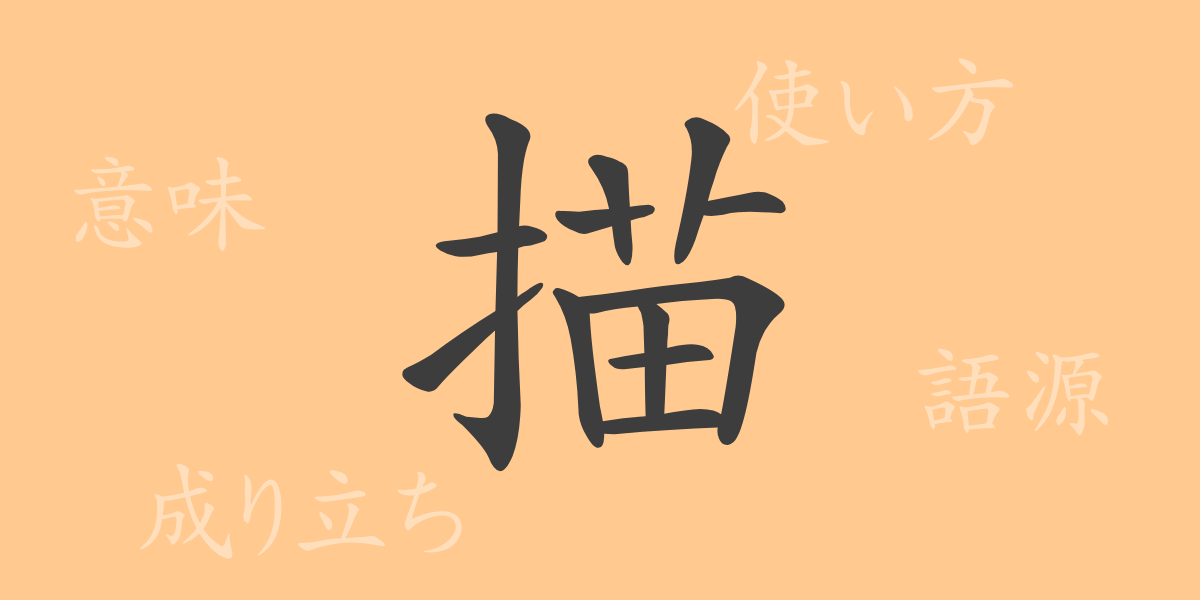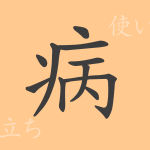Letters are a treasure trove of culture, each imbued with deep meaning and history. The commonly used Japanese kanji “描” (びょう, byou) is no exception. In this article, we will delve into the origins, meanings, usage, readings, and related compounds of “描” (びょう, byou), unraveling the story behind this frequently seen character in everyday life.
The Origins (語源, Gogen) of “描” (びょう, byou)
The kanji “描” (びょう, byou) has evolved from ancient Chinese pictographs. Originally, it depicted a hand holding a brush to draw a picture, combining shape and meaning to form the current character “描” (びょう, byou). The left side of “描” (びょう, byou) is “扌” (てへん, tehen), a radical meaning hand. The right side is “苗” (びょう, byou), which originally represented the growth of plants, evoking images of growth and development produced by the act of drawing.
Meaning and Usage of “描” (びょう, byou)
“描” (びょう, byou) means “to draw or write with a brush or other tool” and “to describe in detail.” For example, when drawing a picture, you might say “風景を描く” (ふうけいをえがく, fukei wo egaku) meaning “to draw a landscape.” When writing, you might say “彼の人柄を描く” (かれのひとがらをえがく, kare no hitogara wo egaku) meaning “to describe his character.” Additionally, “描” (びょう, byou) can be used for abstract concepts, such as “計画を描く” (けいかくをえがく, keikaku wo egaku), meaning “to draw up a plan,” and is also utilized to illustrate future visions.
Readings, Stroke Count, and Radical of “描” (びょう, byou)
The kanji “描” (びょう, byou) reflects its richness in form and meaning through its readings and structure.
- Readings: The On-yomi (音読み, onyomi) is “ビョウ” (びょう, byou), and the Kun-yomi (訓読み, kunyomi) are “えが.く” (えがく, egaku) and “か.く” (かく, kaku).
- Stroke Count: It has a total of 11 strokes.
- Radical: The radical is “扌” (てへん, tehen), which means hand.
Compounds, Idioms, and Proverbs Using “描” (びょう, byou) and Their Meanings
Compounds and idioms containing “描” (びょう, byou) demonstrate the breadth of its meaning. Here are a few examples:
- 肖像を描く (しょうぞうをえがく, shouzou wo egaku) – To draw a portrait of a person’s face or figure.
- 未来を描く (みらいをえがく, mirai wo egaku) – To plan for the future or envision upcoming times.
- 夢を描く (ゆめをえがく, yume wo egaku) – To have ideals or hopes in one’s heart.
- 計画を描く (けいかくをえがく, keikaku wo egaku) – To draft a plan or scheme.
- 情景を描く (じょうけいをえがく, joukei wo egaku) – To describe an emotional scene or landscape in detail.
Summary of “描” (びょう, byou)
The kanji “描” (びょう, byou) transcends being a mere character, symbolizing the acts of creation and expression. From drawing pictures and writing characters to sketching abstract futures and plans, its usage is broad and plays a vital role in our language. By understanding and appropriately using this kanji, we can enhance our communication richness.

























